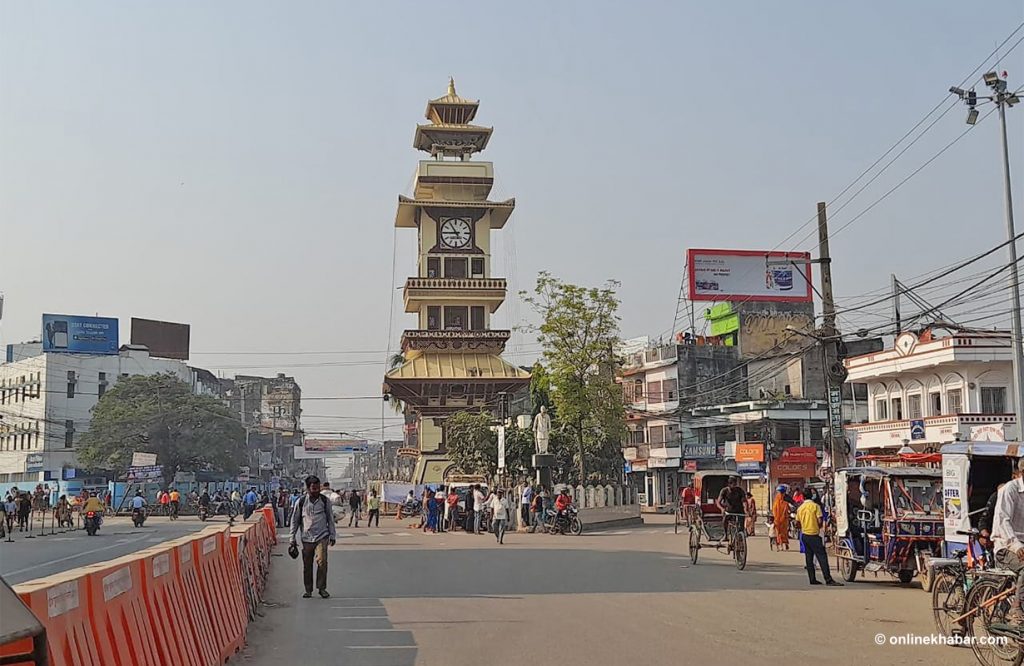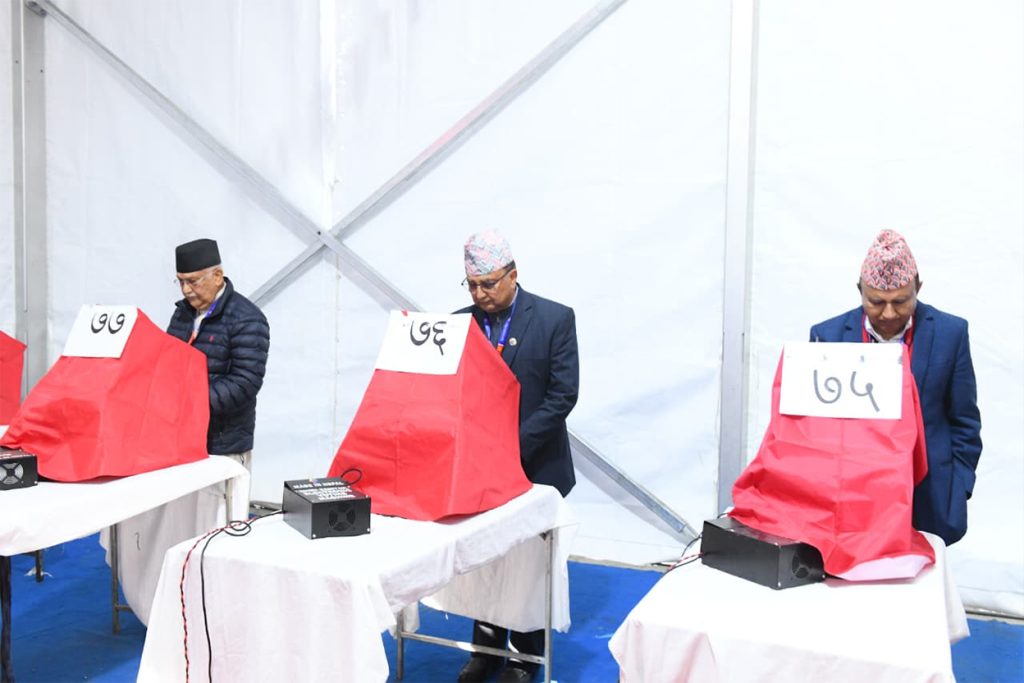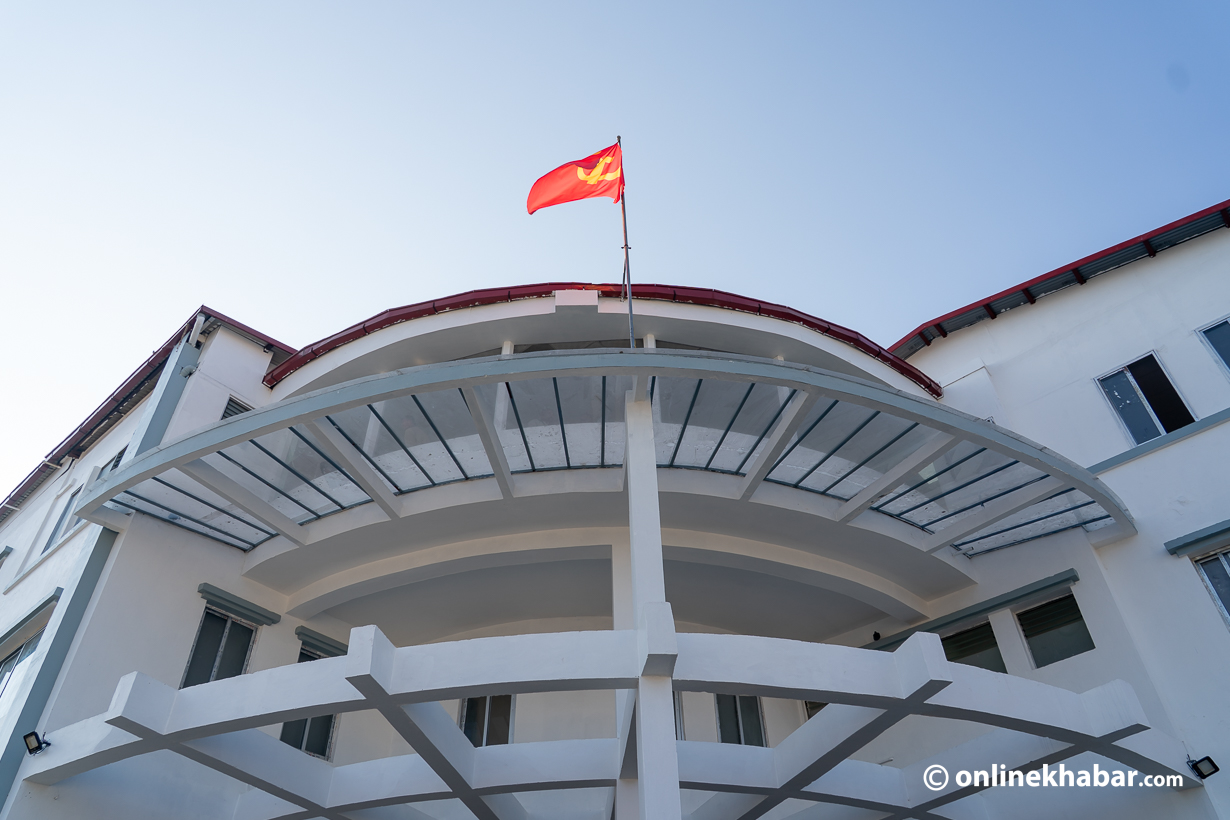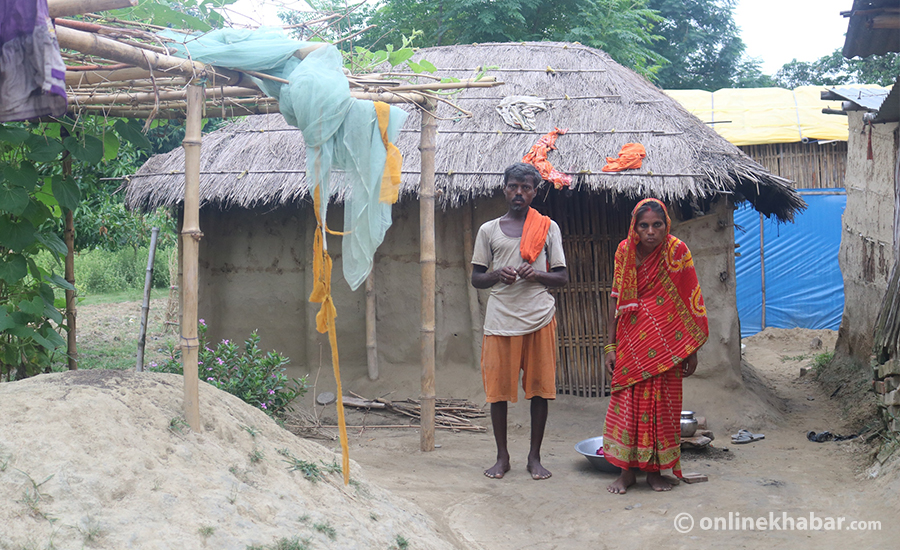
Birgunj, October 7
Ramdev Paswan of Kalaiya Sub-Metropolitan City-10, Motiarwa filed an application after he heard from fellow villagers that the government was going to build houses for poor dalit families.
Paswan, a daily wage laborer, and his wife, who is differently-abled, is raising four children. The only property they have is a hut.
If one is to look at the People’s Housing Program, Paswan should be on the priority of initiative. But he could not benefit from the program. After he wasn’t selected for the program, a question has sprung up in his mind. For whom is the program introduced for the benefit of poor dalits?
Paswan has no other option but to watch the government build houses for people well off than him. “I did apply for the People’s Housing program. But I wasn’t selected,” he adds. “People richer than I am had their houses built, I could do nothing but watch in dismay.”
Ramdev Paswan is not alone, numerous poor dalit families live in Motiarwa. They really need a house. While many of them did not know about the scheme, those who applied did not get listed.
Although the scheme was meant for the poor, the rich have had their houses built, said Israyil Miya of Motiarwa. Mohammad Hasan Dewan (Haroon) also says that people who have connections, those that can speak up and get votes for political leaders have had their houses built under the People’s Housing Program. He says, “There are ultra poor people in the village, they should be the ones getting the new houses. In Dusapatti a new house has been built for a man whose son is earning money abroad.”
Haroon added,”Ramdev [Paswan] doesn’t have anything. They did not build a house for him.” Kamo Devi Paswn, another resident of the Matiarwa, said that the government should have built houses for poor. She says, “Ramdev is economically weak, his family eats when he earns, on days he doesn’t earn, the family remains hungry.”
Kamo Devi, who is also a member of the civil dialogue forum, said, “Programs are introduced for the benefit of the poor and deprived, but those close to power reap benefits from it.”
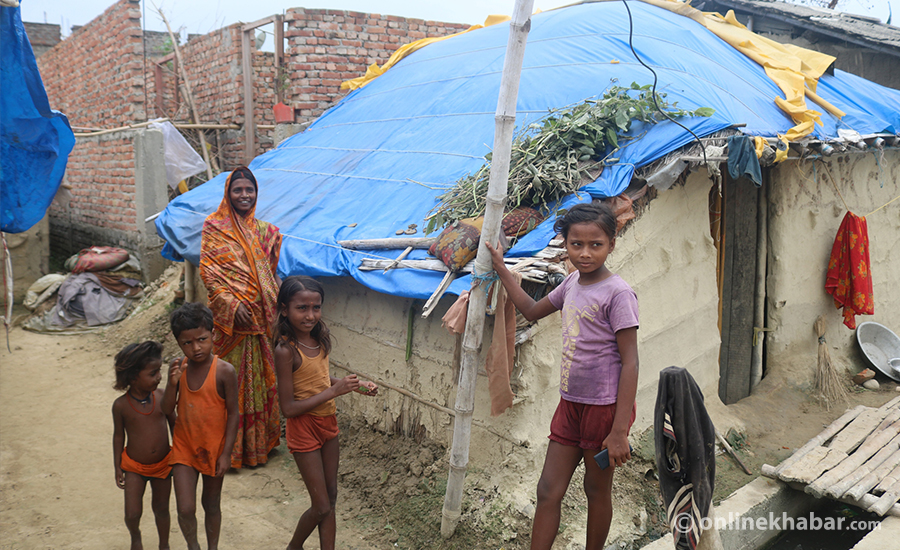
Mina Devi Paswan, meanwhile, has had the construction work of her house halted. “After a round of work was completed, they told me that my name was not on the list,” she says, “After that they did not return.” Mina’s husband Bhayar says that after the ground was dug for the foundation and Mina was called to open a bank account, they told the family that another Mina Devi in the village, not her, was the real beneficiary.
A handful of houses have been built in Kalaiya Sub-Metropolitan City-10 Nilkanthawa. But Bhikhari Hajra’s house remains incomplete. “They said they haven’t received money. Water trickles from the ceiling, it’s difficult to live here,” says Hajra’s daughter-in-law. “It’s been three years, the house is not complete yet.”
Beneficiaries face barrage of problems
Thirty-four houses were selected to participate in the scheme in Bahudar Mai Municipality-5, Burwa. Of the 34 houses planned, work on four could not begin over a land dispute. In an area dominated by Chamar and Dusadh communities, the houses of Nagendra Paswan, Ram Mani Ram, Jadu Mahara, Dev Sharan Mahara, Shiv Balak Mahara, Pundev Mahara, Suresh Mahara, Lakhraj Mahara, Bala Ram and Jagan Mahara are yet to be completed.
There are places where the construction committee chairs have been accused of prioritizing their own homes over that of other beneficiaries. But construction committee chair Harindra Paswan says he hasn’t built his own house yet. “Building my own house without building others’ would send a negative message,” he said.
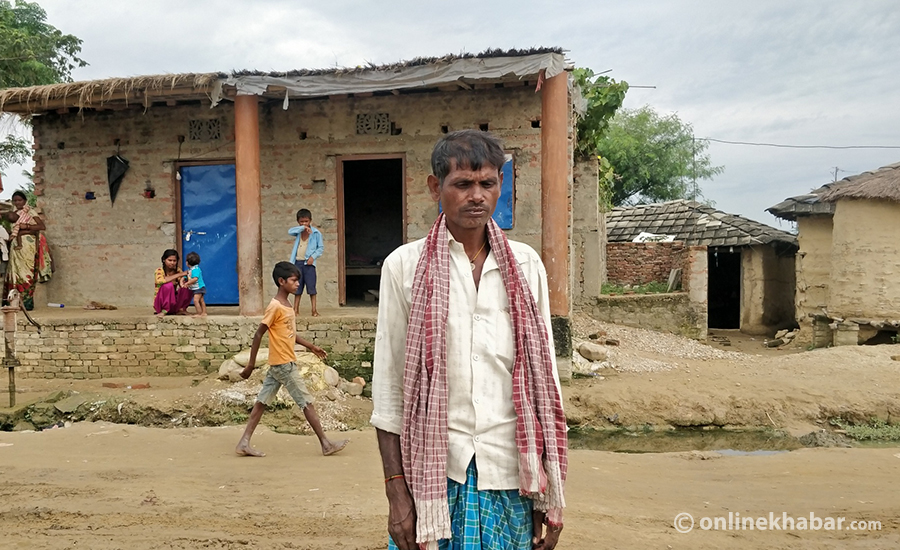
In Bara, a thousand households were listed as beneficiaries of the program. Of the thousand, 893 households have signed agreements. While most of the households have received two installments of the grant, there are some houses that have been abandoned after digging the foundation.
Construction of the houses of Balaram, a resident of Parsa’s Bahadurmai Municipality-5, and his uncle have also been stalled due to lack of funds. The two families razed their huts in the hope that they will get to live in a concrete house. As their house was razed, they haven’t been able to sleep well in the rainy season. He said that he had to sell his cow after it got wet in the rain. Balaram’s uncle, who is also on the list of beneficiaries, is also living in another house.
“The house could not be completed because of the lack of funds. For the last two years, we have no option but to get wet,” he added. He said, “The contractor does not work without money. We don’t have money to do it ourselves.”
Saheb Paswan of Ramgadhwa is also worried. His house doesn’t have doors and windows. Authorities have told him there’s no more money left. Similarly, at Shiva Balak’s house, the roof is yet to be laid. Jadu Mahara does not have money to pay the laborers. That is why he has ‘loaned’ 20 sacks of cement to a school. They haven’t returned it. Two trucks of sand and bricks have been brought. Desh Saran’s house is in limbo after it allegedly encroached upon a local canal.
Under the People’s Housing Program in Rautahat, each household has been allocated a budget of Rs 214, 700. In Bara, the amount allocated is Rs 332,500. The amount is disbursed in four installments. The second, third and the fourth installments are disbursed only after the house if completed. Those people who had the money to build a house have already completed construction. The poor who do not have the money couldn’t complete their house.
It’s not just in Parsa, Bara and Rautahat where the People’s Housing Program’s progess has not been satisfactory. To implement the program, the government has setup offices in Birgunj, Janakpur and Saptari. The office in Birgunj looks after work in Parsa, Bara, Rautahat and the Janakpur office oversees work in Dhanusa, Mahottari and Sarlahi. The Saptari office is responsible for activities in Siraha and Saptari.
According to the Saptari office, 1,133 households in Saptari and 1,099 in Siraha signed agreements to construct houses. Only 50 per cent of the households have constructed house. Around 70 per cent of the households have laid their roofs, but most of them have not completed their house.
The office’s deputy chief engineer Krishna Dev Jha said that the program has so far received Rs 152,511,000 from the government out of which Rs 564,065,250 has been disbursed to beneficiaries
If you are connected, you get a house
Under the program, there was an agreement to build 25 houses in Birgunj Metropolitan City-29, Sugauli. Seven households are yet to receive their final installment. The construction committee chair in Sugauli is Sukhlal Hajra Paswan. He is a representative of the Nepali Congress General Convention.
Sugauli was earlier under the ambit Parsa-1 during the Constituent Assembly elections. As Constituent Assembly Member Rajendra Bahadur Amatya of the Nepali Congress won from the constituency, the NC’s Sukhlal Hajra Paswan was given the responsibility to head the program. This is just an example. Under the People’s Housing program, beneficiaries have been chosen based on party politics and committee members have also been chosen in similar vein.
In Birgunj-23, NCP district member Meghraj Paswan’s house has been built under the program. Locals say that Paswan already lived in a concrete house. Similarly other residents of the village Sambhu Das Tatwa, Karmin Paswan, and Suraj Paswan (Chaukidar) have a house in addition to the ones built under the People’s Housing Program. Samal Paswan inserted his wife’s name on the list of beneficiaries to win a house. Many others like him used their wives’ or children’s name to claim a house.
Constituent Assembly member Bicharu Yadav, however, says the program has achieved good results as she herself has taken the initiative to manage it. “A total of 117 houses have been built in my neighborhood. Dusadh and Tatwa who were poor now have houses. Only two houses could not be built, “she said adding, “I monitored the work there. I stopped people who already had a house from getting the grant.”
Lal Babu Yadav, a ward member of Birgunj-23, says that although the program was aimed at the poor, rich people benefitted from it. “They said that the work will be carried out under the consumer committee, “he added, “They only disburse money after the work is completed. How can poor people afford to do that?”
In Birgunj-24, Ramgadhwa, Hajari Baitha, Pahawari Baitha, and Mamtaz Ansari have had their houses built under the program. However, they are well off people, locals claim. Bijaya Prasad Kurmi, the president of a local youth club, says that rich people have built new houses with the grant in the name of the poor. “The program should have built houses for the poor, but it has done so for the rich.”
Kismati Devi Ram, the chair of the Bara chapter of the Federation of Dalit Women, says community leaders and engineers benefitted from the program.
What does the procedure say?
Article 42 (2) of the constitution of Nepal says that the stat shall make provisions to provide special benefits to the poor, and endangered communities by providing them opportunities to uplift themselves, receive facilities such as education, health, housing, employment, food and social security among others. It was 10 year ago that the government allocated budget for providing housing to the poor, dalits, and Muslims identified by the national dalit commission.
To implement the program, a working procedure was prepared 10 years ago. The procedure was revised in 2016. The new procedure says that under the program, a house shall be re-constructed for the beneficiary on the same land where the beneficiary is living. It also says that the house shall be deemed to have been completed only if its toilet is also completed.
According to the procedure, the beneficiary has to contribute 10 per cent of the budget for the construction. It says that the contribution can be made through cash, kind or labor. If that is also not possible, the toilet should be built by the beneficiary.
The procedure authorizes the district coordination committee to select beneficiaries for the program. But it specifies the guidelines under which such selections have to be made. But during our field visit, we found that the procedure has not been followed.
The dossier says that the committee shall receive applications, then vet the application to select families that are poor. Senior citizens, widows, destitute children and differently-abled people are to receive priority, says the program’s guiding document.
It says that if 10 people of a village are selected for the program, they have to form a construction committee. That was why the committees were formed. But the committees hired people from outside to build the house. Bara coordinator of the program Paras Shah says, “They have pocketed some of the money. Under the first installment, they should have given the households Rs 93,000 each. But we found that they gave only 80-85,000.”
The coordinators of the program in Bara and Parsa have suggested that the design of houses built under the program should be amended. They say that the houses should be resilient to disasters. According to the government-approved design, houses built under the program shall not be painted. The floor should be made of mud and the doors and windows as well as beams for roof should be made of bamboo. Every corner should have 1-1 iron rod. Sub-standard bricks should be used.
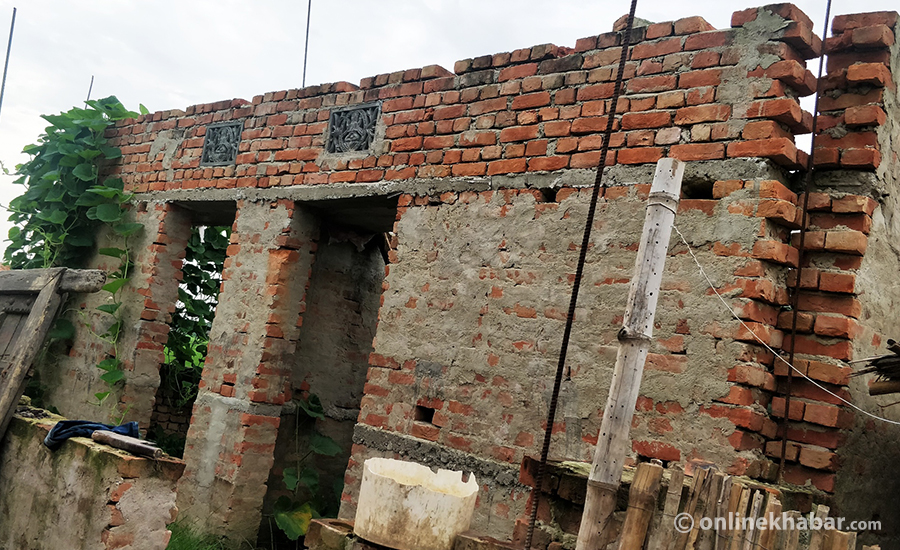
Bara district coordinator Shah says, “The design itself is faulty. We now need to build quake-resistant houses with toilets. The estimate itself says sub-standard bricks shall be used. Why do that?”
He said, “We should have provided at least Rs 500,000 so that they could build a room, kitchen and a toilet.”
He says that as the price of construction materials has spiraled, the government should also hike the grant amount. “The price of construction materials has shot up. Cement which could be bought for Rs 400, now costs Rs 800 per sac. When the estimate was prepared, the iron rod would have cost Rs 7,000 now it has crossed Rs 10,000. Labor wages have also gone up,” he said, “The grant amount should also have been hiked.”
The program’s Parsa coordinator Ramesh Patel said houses built under the guidelines were not worth it. “The house is not plastered, nor is it painted. The windows are made of bamboo. We should at least give them a painted house with two rooms, a kitchen and toilet.”
Three years, 20 per cent progress
The government announced nine year ago that the program will be implanted in Saptari, Siraha and Kapilvastu. After that it was expanded to all districts except Kathmandu. According to the government’s target 16,000 houses should have been built in the eight districts of Province 2. But that hasn’t happened.
It was hoped that the program would save the poor from the sun, rain and cold. But the centre-backed program remains affected due to poor coordination with the government of Province 2.
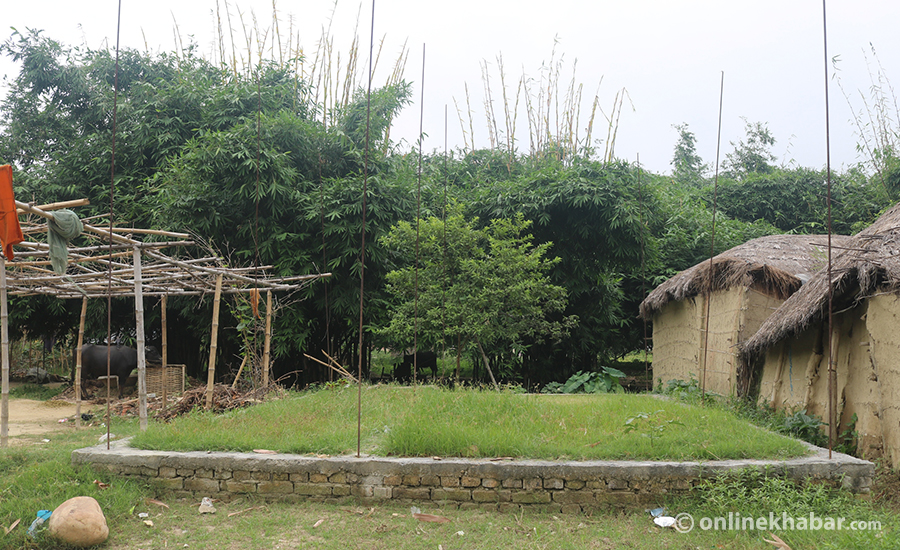
In April disaster struck Parsa and Bara when hundreds of houses were destroyed by gale-force winds. The government handed over the responsibility of building houses for the survivors to the Nepali Army. The army started work in May and has handed over 869 houses to the local people, despite adverse weather conditions. The houses are not just sturdy, they look good and the work is of good quality.
But houses built under the People’s Housing program are in shambles. The Nepali Army, in some places, built houses for people who were already building houses under the People’s Housing Program.
According to the goals set by the program, 6,000 houses should have been built in Parsa, Bara and Rautahat until now. But that has not happened.
Prospective households in districts under the jurisdiction of the then Urban Development and Building Division, Birgunj: Parsa, Bara and Rautahat, signed agreements for 2,809 units, but only 1,566 have been constructed so far. Most of the houses here have also not built toilets as part of the agreement. Of the Rs 455,618,000 allocated to the three districts, only 20 per cent has been disbursed this fiscal. The program disburses money only after construction work is completed. That is why the disbursal rate is around 20 per cent, officials say.
After the office came under the ambit of the provincial government, beneficiaries are preparing to build 775 houses in Saptari and 832 in Siraha this fiscal. According to the Urban Development and Building Office, Janakpur, 996 households started building houses two year ago; 521 have completed construction work. In Mahottari, 574 houses which were started the same year are yet to be finished.
Acting office chief Mahendra Mahato says that of the Rs 382,092,000 provided to the program, only Rs 141,735,832 (around 37 per cent) has been disbursed so far. The office says it has been disbursing money to households that started work on the house years ago but completed it just now. In addition to that, the office has signed agreements for 289 houses in Sarlahi, 223 in Mahottari and 231 Dhanusa this fiscal.
“We have signed agreements to build these houses,” said Mahato. “But we haven’t received money for the new houses,” he added.
Consumer committee chair Harindra Paswan says it is hard for beneficiaries to work on the house without the grant. “I am ready to work but they do not support me. They say that I should build their houses as I am the chair of the committee. “The program says sub-standard bricks should be used. Some people ordered standard bricks, the cost went up. Others loaned their cement.”
Why were the houses not built?
The program was launched three year ago. The beneficiaries say that they faced a shortage of construction material in the beginning. But as the office had money, it was ready to provide installments as and when needed. Authorities say that conflict between the committees, beneficiaries and the shortage of labor and materials also hampered the project.
Janakpur office’s Mahato says, “We don’t have the resources to monitor the program. When we opened our office, they said that they would provide five motorcycles and one vehicle, none of it has come so far.”
According to a source, the office should have been given one divisional engineer, three engineers and an overseer. But it has only been given two engineers. The vehicle given to the office is being used by the minister of state for agriculture.
Vested interests dominate
Around 16,000 people applied to the program thinking that they could now live in a concrete house. The needy should have received priority, but the then MPs disregarded the applications to divide the program into quotas based on electoral constituency. Each MP received 200 quotas. The lawmakers not only selected people close to them for the program, they chose their allies to head the committees. Sukhalal Hajar Paswan of the Nepali Congress and Harindra Paswan of the then UML are examples.
In Bara, however, dispute erupted between MPs. This led to the stalling of the program by a year in the district. The next year, the program was rolled again with an increased budget. That was why the budget for each household in Rautahat and Bara reached Rs 214,700 in Parsa and Rs 332.500 in Rautahat.
Saroj Kumar Goit, the Parsa chief of Province 2’s Urban Development and Building Office under the Ministry of Physical Infrastructure, remembers how committee coordinators tried to take political benefit from the program and include people close to them on the list. Goit started the program in Birgunj when it was under the ambit of the central government. The conflict between Goit and then MP Raj Kumar Gupta over the program had been widely reported in the press.
“When we started work, I was under lot of pressure. Political leaders even told me that I should keep the program a secret and do what they tell me to do,” he added, “We might have erred under pressure, but we did not discriminate when choosing the beneficiaries.”
The program’s Bara district coordinator and provincial assembly member Paras Shah concedes that the program had some weaknesses when it was run by the central government. “When we visited the houses, we found that around 10 per cent of the people were from outside the intended beneficiary group,” he said adding, “We saw that people who already had a house were also included. We stopped around 50 households from receiving payment for their second house.”
Parsa coordinator of the program Ramesh Patel, who is also a provincial parliament member, argues that the beneficiaries themselves did not exercise required caution. “We saw that the beneficiaries also tried to extract more benefits. They took the first installment but did not start construction. There were others who had already claimed the second installment, but hadn’t done anything.”
Opportunity for provincial government
The Province 2 government’s plan is to prioritize houses for the members of the Dom, Musahar, Halkhor, and Mestar communities. The provincial government plans to build houses for other communities only in the second phase. After the country adopted federalism, the program is being implemented by the provincial government since this fiscal. The provinces are preparing their own procedures to run the program.
The central government’s guidelines said that the 25 per cent of the grant shall be disbursed after the foundation is laid, 30 per cent after the plinth is prepared and 30 per cent after the walls are built. The final 10 per cent would only be released after the windows, doors and a toilet were put in place. The provincial government has changed that.
Under the new procedure, a central steering committee will be formed under the leadership of the Minister for Physical Infrastructure. In the districts, the committee shall nominate a provincial assembly member as the coordinator. Under the new procedure, beneficiaries shall receive the grant in three installments of 35, 50 and 15 per cent.
However, after the provincial government only selected lawmakers from the ruling party for the program, the main opposition, the Nepali Congress obstructed provincial assembly proceedings over the issue.
The provincial government has now started building new houses in Sarlahi and Dhanusa. Community leaders say that the program gives an opportunity for the provincial government, which has been criticizing the centre for its failure, to show how things are to be done.






